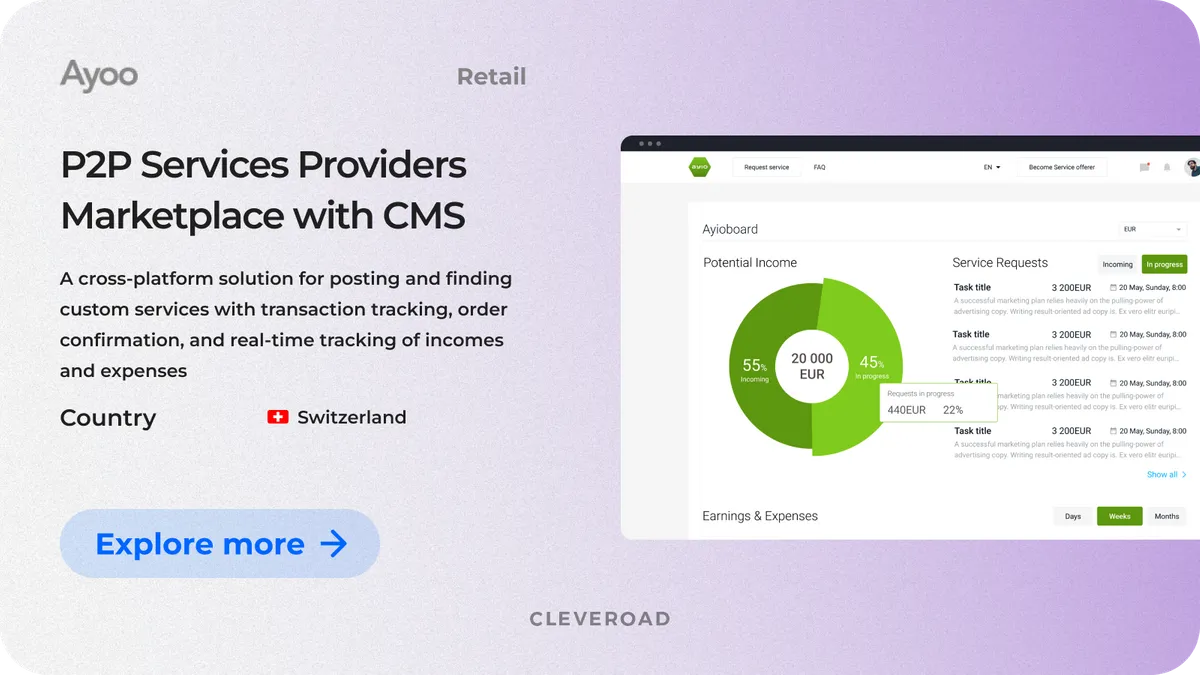How Much Does It Cost to Build a Marketplace Website [Full Estimate]
Updated 03 Apr 2025
20 Min
8475 Views
How much does it cost to build a marketplace website? The development requires various services that aren't cheap, and your idea may cost tens of thousands. For anyone who wants to know the cost of building a marketplace website, our comprehensively guide shows the price feature-by-feature and the total cost across different regions.
To put it short, the cost of building an online marketplace varies from $41,000 to $281,000 and higher. It depends on the complexity of the features, at 50$ per hour, the average price will be:
- Simple online marketplace: $41,000-$80,000
- Medium online marketplace: $80,000 - $150,000
- Complex online marketplace: $150,000-$280,000 and more
Please note the numbers are approximate, every marketplace case is unique and should be estimated individually. So, read our article to find out exactly what factors affect cost and how much your particular marketplace idea could cost you.
What Is an Online Marketplace Concept and Why It Is Beneficial?
The marketplace notion represents the e-commerce platform, an online store that delivers data regarding the product or service of third parties. On the whole, the marketplace is a streamlined online platform for the provision of goods and services. The same item can often be offered by numerous sellers, which makes the price highly variable. Due to the fact that online marketplaces aggregate goods from a great diversity of purveyors, the selection of these products is wider, and the availability is higher than in specialized physical spots.
The concept of each marketplace is diverse, so understanding how much to develop online marketplace is also different, yet there are some mandatory requirements it must comply with:
- There is a primary structure that manages all the operations performed on the website.
- The marketplace offers the products of other vendors and has an elaborate algorithm due to which they begin trading.
- Terms and conditions of cooperation are well-defined and clear for all the parties: commission, requirements for delivered goods, quality of service, etc.
Marketplace development perspectives
The necessity of making online purchases has risen substantially since the global pandemic has drastically changed the life of society. Today, people don’t imagine the world without it, buying online and generating revenue for online marketplace owners. If you build your own marketplace, you’ll get a promising product that can bring a lot of benefits and income. Let’s look at the statistics that prove it:
- A study by TechNet found that 85% of small businesses reported that online marketplaces allowed them to reduce a business's overall cost, and 92% agreed that these platforms let them to reach potential customers more easily.
- Statista's analysis indicates that the retail online segment will make up close to over 21% of total global retail sales by 2029.
- The Sun survey in the UK shows that two-thirds of 2,000 adults engage in buying and selling on online marketplaces, with an average of 21 items exchanged per year.
- Investor's Business Daily reports that large retailers also capitalize on the online marketplace model. For instance, Walmart and Costco have reported e-commerce growth rates of 27% and 19%, respectively, outpacing Amazon's 9% growth.
Marketplace website monetization models
The approach to profit generation should be particularly carefully selected in case you are planning to cover the cost of creating an online marketplace website.
Let's list what options you have to make your business fruitful.
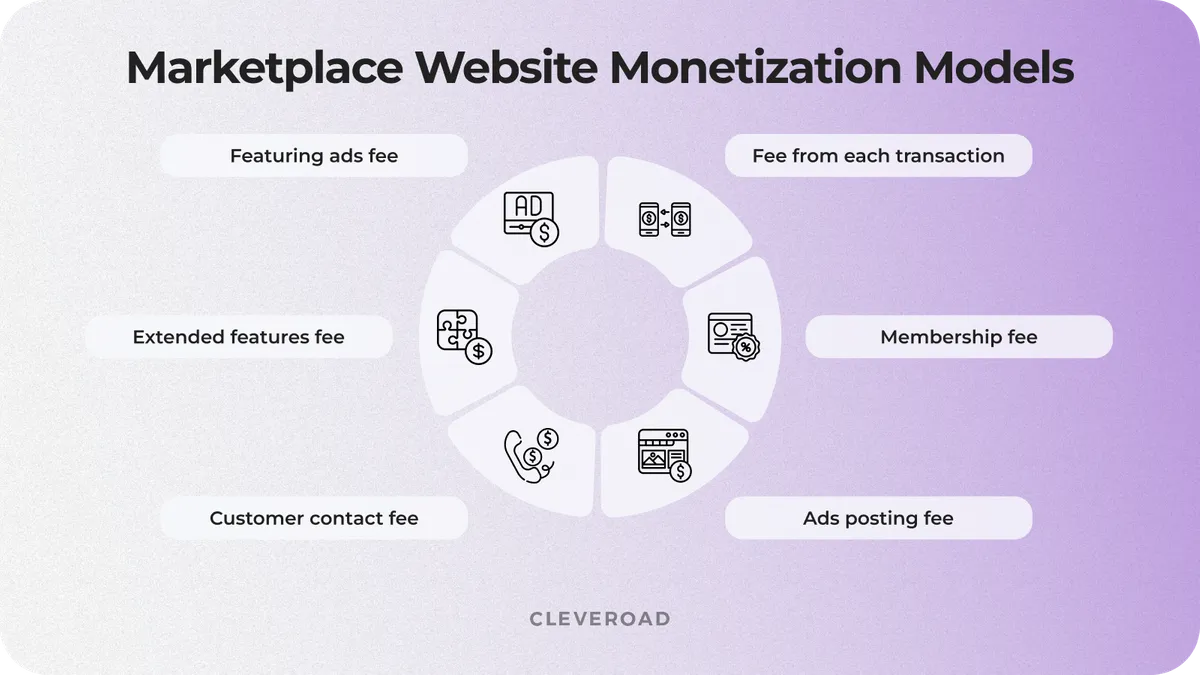
Marketplace website monetization models
Fee from each transaction
This type of monetization is highly appreciated by the sellers who place their products. This is due to the fact that when operating under these terms, they are not charged by the online platform until they generate their first revenue. For the owner of the marketplace, this is also convenient since all cash flows are performed and processed by the web solution.
Membership fee
This model assumes that specific (or all) users of the marketplace are obliged to stably be charged for a set amount of financial resources to have access to the platform and the opportunity to attract a new audience or providers. In contrast to the approach above, this type is excellent for an online platform that offers expensive products or services.
Ads posting fee
Online stores that aggregate a vast number of ads are described by a pay-per-placement monetization type. Its concept is similar to the posting of paid ads. This model is a brilliant choice when the supplier would like to cover the capability to engage an extended client base, and the platform is able to ensure a sufficient audience. The ad-fee business model is pretty beneficial for the B2B segment as well.
Customer contact fee
Paying the owner for contacting the customer or lead generating is a popular online marketplace business model commonly implemented in many modern marketplace platforms. Their users leave requests and wait for offers and responses from appropriate vendors. The marketplace takes money to connect a performer with a potential client who is interested in its services.
Extended features fee
The essence of this monetization model is that the consumer can benefit from the basic marketplace functions of the service for free and pay for advanced features if desired. Also called freemium, this type differs from the trial version, where the user gets free access for a certain period of time. This model allows you to use the essential functionality of the site without any time restrictions.
Featuring ads fee
Featuring is an opportunity for vendors to reserve a more beneficial placement for their product or service. This model is similar to advertising. Yet, in this case, as a rule, ads are placed on the site for free, and vendors can pay the marketplace to get their listing in a higher and more viewed position on the website: on the home page or on the top positions of certain categories.
Types of Online Marketplace Solutions
Before we jump right into how much does it cost to start a marketplace, let’s see the types of marketplaces. It is important because the kind of marketplace determines its functionality, the complexity of its web or app development, and, consequently, the cost.
There are three types of e-marketplaces:
- Vertical that occupies one area or niche
- Horizontal that offers goods from a few categories with a secondary character in common
- Global that offers items or services from a wide range of categories
Let’s take a more detailed look at types of online marketplace solutions.
Vertical marketplaces
Vertical marketplaces offer goods from multiple sellers but the type of items is the same. They are exclusive suppliers that offer specific goods and have top-notch sellers. For instance, on Zillow, it’s free to list a home for sale or rent. The platform works with many owners and agents/brokers, but their services incorporate purchasing, renting, or selling apartments.
Another bright illustration of the vertical marketplace is ThredUp. According to DMR, the number of its engaged buyers is 1.632 million, and the number of active sellers is about 428 million. Document Thredup distribution center has over 100 million items processed.
Horizontal marketplaces
Horizontal e-marketplaces sell goods or services in several categories but with a single common characteristic. These marketplaces count to a broader audience than vertical by offering diverse products or services with a common similar pricing model, target industry, or purchasing process.
For example, Couchsurfing works with and for travel, and Etsy sells handmade items in eight categories. DogVacay offers different services but only to people with pets. Craigslist, is another prime example of a horizontal marketplace. According to Semrush, this marketplace is the 79th most visited website in the US now.
Global marketplaces
Global marketplace offers a great diversity of goods – books, furniture, groceries, apparel, toys, software, appliances, and a whole lot more. They consolidate lots of market segments to satisfy more consumers. This type of online marketplace is focused on customers whose priority is high speed and lowest price. There are many categories of goods, and sellers’ price offers are competitive.
Amazon is a great illustration. Yep, it became famous for selling books, but today, you can buy literally anything on Amazon. And if you want to build a marketplace website like Amazon, the statistics will say it’s a good idea. Statista states it hit nearly 638 billion U.S. dollars in net sales revenue worldwide in 2024. The number of Amazon registered users is 290 million, and the total sum of profit is $59.2 billion in 2024, another massive annual increase.
We can also categorize marketplaces by target audience:
- B2B marketplace(business-to-business) — websites that sell various products from one business establishment to another. Multiple wholesalers are allowed to connect to purchasers to provide them with products/ services in bulk.
- B2C marketplace (business-to-customer) — business provides products directly to customers.
- P2P marketplace (peer-to-peer), sometimes called C2C (customer-to-customer) — the websites are intermediaries between product owners and sellers interested in it.
Our marketplace development services cover various e-commerce solutions types. Learn how we can help you in creating your own online marketplace idea
Factors Affecting the Cost of Building a Marketplace Website
Various factors influence the final cost to build a marketplace app, such as platform complexity, technology stack, developer’s hourly rates, and more. So now, let’s discuss the most common marketplace website cost drivers.
Marketplace app complexity
Marketplace app complexity is one of the most crucial parameters in determining the cost of a website development. Consequently, a simple marketplace would be restricted to catalog displaying and checkout processes, which makes it less expensive but also greatly deficient in features. Medium-level solutions include more than one vendor service, possibly enhanced filtering, and third-party integrations. Complex marketplace apps have to scale horizontally in marketplace architecture, causing much more impressive orders of magnitude of development cost to build a marketplace app.
Check the approximated cost estimation for different marketplace complexity:
| E-marketplace complexity | Features | Cost ($) |
Simple platform | User authentication, product listings, basic checkout | $41,000-$80,000 |
Medium platform | Multi-vendor support, advanced search, payment | $80,000 - $150,000 |
Complex platform | AI-driven recommendations, real-time analytics, custom dashboards | $150,000-$280,000+ |
Custom UI/UX design
Your platform design also affects the cost of creating an online marketplace. There are two types you can choose from - ready-made templates and custom designs.
Let’s discuss them in more detail with estimated costs:
- Ready-made templates – $5,000-$15,000+. Ready-made templates tend to be lower in cost than custom UI\UX design services but have troubles with customization, and it will not be possible to create a unique product that will immediately evoke associations with the brand.
- Custom UI/UX – $30,000+. Design for a marketplace website from scratch takes more resources and time to deploy, such as UI/UX branding, wireframing, prototyping, and testing.
So, custom UI/UX requires a higher cost to design and build your marketplace design than ready-made templates for online marketplaces, but a custom design offers more opportunities for branding, allows to increase brand awareness, and improves customer loyalty.
We’ve discussed how much does it cost to design a mobile app in our article. Check out to learn more
Technology stack
To find out how much does it cost to develop a marketplace app, you should come up with the essential features because there are such that developers need to develop from scratch using programming languages, frameworks, and libraries and such they can implement faster with the help of third-party APIs. IEEExplore study shows that there’s a good chance the product creation will require the implementation of in-app search (technology: Elastic Search), payments (Braintree, Stripe), and online chat (Firebase). Each integration requires its unique resources and developer’s expertise, so it will increase the marketplace development cost.
Here are some technologies we typically use for e-commerce and retail software development:
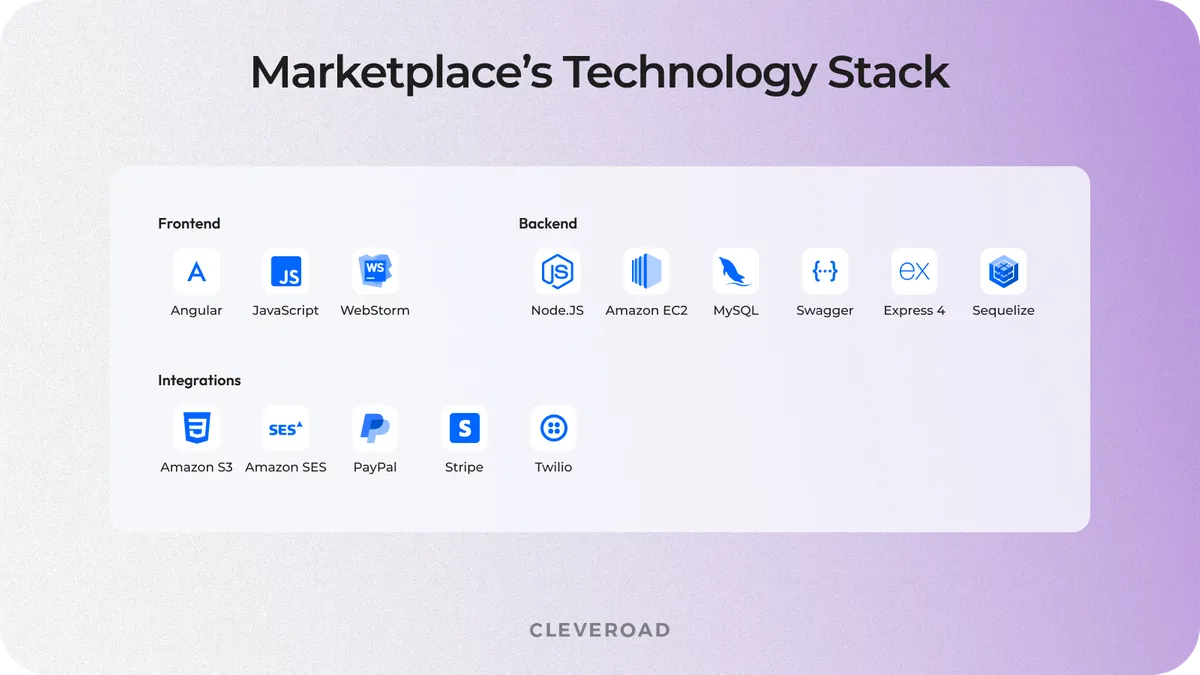
Marketplace’s technology stack used by Cleveroad’s team
Cooperation option
The cooperation option you choose directly influences the cost of building a marketplace website. You can choose between in-house development and outsourcing.
The in-house team requires you to hire skilled developers, designers, and project managers. This approach provides full control over development but consumes a lot of expenses, including salaries, social benefits, office space rent, hardware, and software licenses.
Outsourcing to an experienced IT vendor, also called dedicated team development services, significantly reduces the cost of creating an online marketplace while ensuring quality. It’s possible because you can hire qualified developers in a country with a lower cost of living and, hence, hourly rates. Also, such cooperation gives access to the global talent pool – you can hire any expert from anywhere in the world.
We’ve comprehensively compared in-house vs outsourcing software development. Read our article to learn more.
Specialists' hourly rates
To determine the cost of developing an online marketplace, you need to know the specialists' hourly rates. They greatly differ by region you want to get experts from. Let’s look in more detail at the online marketplace specialists’ hourly rates depending on the region.
| Online marketplace specialists | CEE | Western Europe | North America | South America | Asia | Australia |
Software developers | $30-$100 | $50-$150 | $60-$180 | $30-$80 | $15-$70 | $40-$140 |
UI/UX designers | $40-$80 | $70-$120 | $80-$140 | $40-$70 | $20-$60 | $60-$100 |
Business analysts | $50-$90 | $80-$130 | $90-$150 | $50-$80 | $30-$70 | $70-$120 |
Solution architects | $60-$110 | $90-$160 | $100-$180 | $60-$90 | $40-$80 | $80-$140 |
QA engineers | $25-$70 | $40-$100 | $50-$120 | $30-$60 | $10-$50 | $30-$90 |
DevOps experts | $40-$90 | $60-$130 | $70-$150 | $40-$70 | $20-$60 | $50-$110 |
Project managers | $50-$100 | $70-$140 | $80-$160 | $50-$80 | $30-$70 | $60-$130 |
What this table says is that North American and Western European providers suggest services of very high quality while charging high salaries, which causes the total cost of the application development to rise. In contrast, IT outsourcing Eastern Europe can reduce development expenses without sacrificing product's level of quality.
Hosting and maintenance
Hosting and maintenance have an impact on how much does it cost to start a marketplace.
To understand the amount of the expenses you may need for this part, here is a list with monthly prices of popular web hosts:
- AWS: 100$ – 500$+
- Google Cloud: 100$ – 400$+
- DigitalOcean: 40$ – 200$+
- Shared Hosting: 10$ – 50$+
A high-traffic marketplace like eBay demands cloud hosting for scalability and uptime guarantees, increasing costs. A budget-conscious marketplace website may start with shared or VPS hosting before upgrading as traffic grows. Regular maintenance, bug fixes, and security updates further add $5,000 – $20,000+ annually to operational costs.
MVP Features for Marketplace Website Development
Creating MVP helps to answer the question, "how much does it cost to build a marketplace website". It is determined by the set of essential features your project requires. Starting a website architecture with an MVP version is a common practice. MVP comes only with the much-needed features, and you can add more sophisticated ones on the way. After all, the faster you launch the marketplace, the quicker you start getting feedback and figuring out what to add or improve.
Before we start, we’ll split the feature list into two categories:
- Customer’s side
- Seller’s side
Time to check what functionality is required for each of them.
Customer’s side
The customer side of a marketplace website plays a crucial role in user engagement and satisfaction. A smooth experience encourages users to explore, purchase, and return to the platform. Here are the main aspects of the customer’s side your platform should contain:
Registration. To get access to all the opportunities of the marketplace, users must complete the signing-up process. To do this, they have to provide their personal info, such as name and email, and set a password. What is more, customers should agree to the Terms and Conditions.
User profile. Authorized users will need to enter and edit their profile details. To illustrate, it may be adding or changing a delivery address, subscription plan, payment method, email, or password. Furthermore, they should be able to check their current/ previous order history.
Advanced filtering. To find suitable goods faster, customers should be able to apply a system of filters (location, price range, conditions, etc.). It will improve the user experience and let users easily and quickly find what they need.
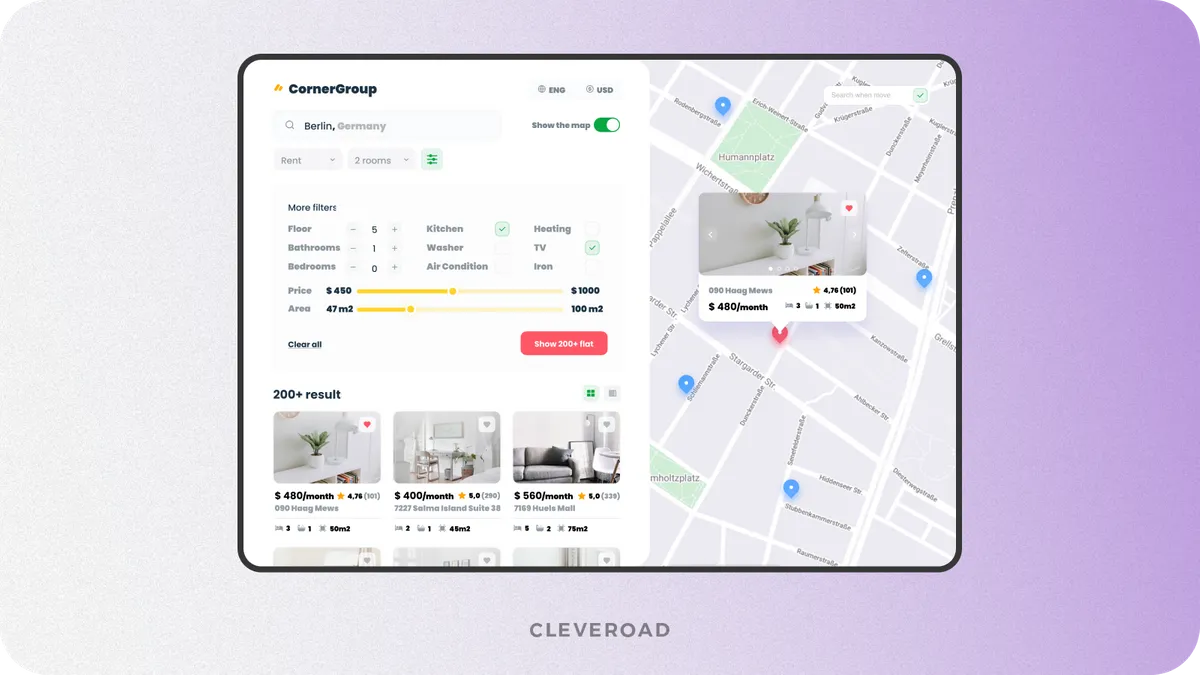
Advanced filtering feature of an online marketplace designed by the Cleveroad team (Source: Dribble)
Homepage. The landing page is a calling card of the platform. The best way to develop the interface is to make it intuitive and user-friendly. Needless to say, the laconic, sophisticated UI/UX design also plays an integral part here.
Product page. The product page should comprise a detailed description of the product, some photos, videos, and prices. Such a section must give short information about the products provided by sellers, which should interest the customer.
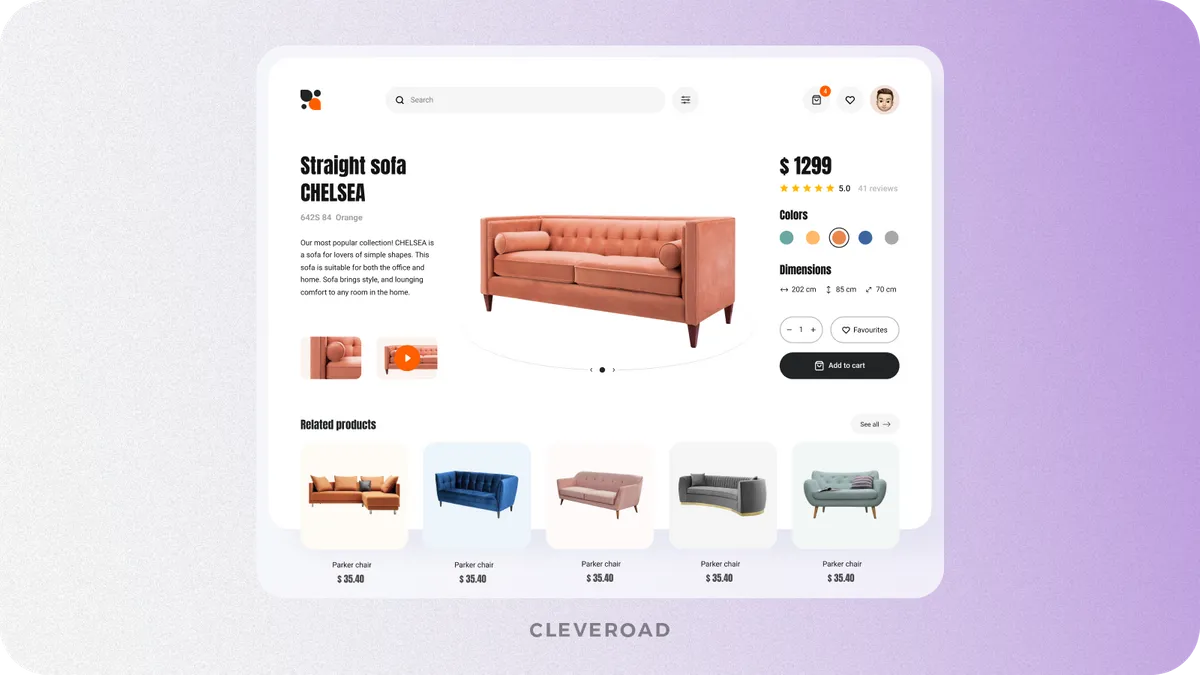
A product page section of an online marketplace designed by the Cleveroad team (Source: Dribble)
Chat implementation. Customers should be able to reach out to suppliers with the help of messaging to bargain, discuss shipping details, or request extra information. It gives more engagement to your product, helping increase the audience.
Shopping cart. The list of products should be displayed here. Users may edit its quantity or remove it from their cart. Users can check the price details, fees or discounts, promo codes, delivery and payment options, and add comments. This section's last stage is proceeding to the payment method.
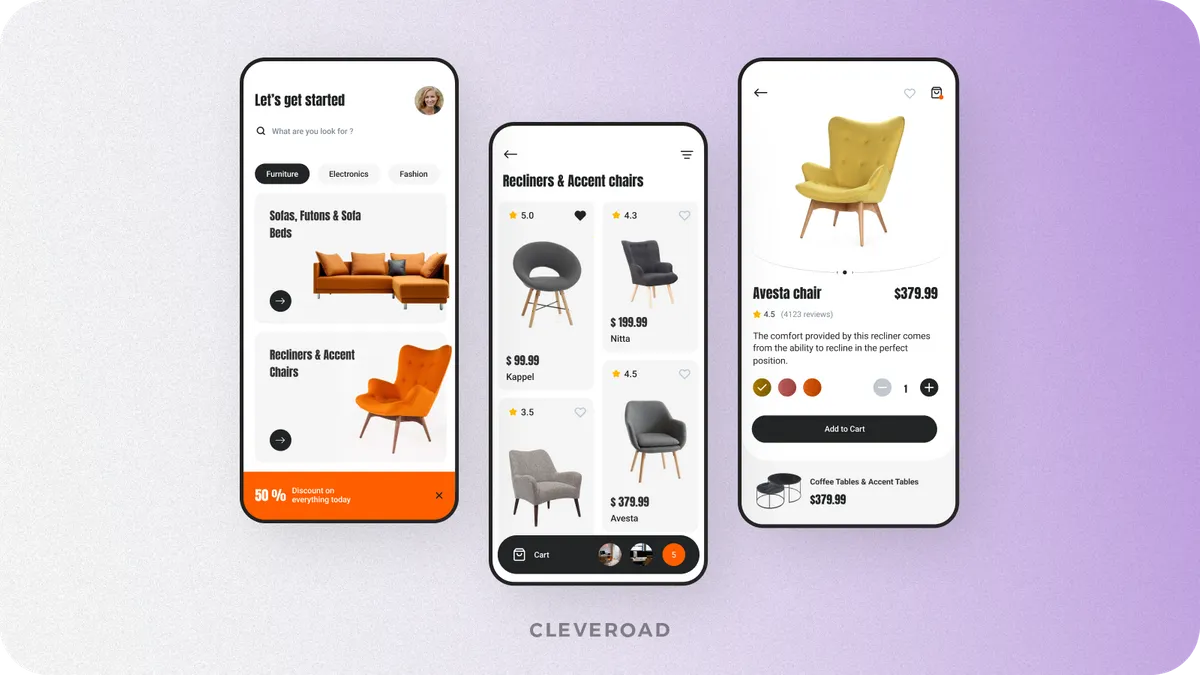
Picture. A shopping cart section of an online marketplace designed by the Cleveroad team (Source: Dribble)
Administrating tools. Clients are allowed to manage vendors by the following actions:
- Searching
- Filtering
- Deleting
- Blocking
Feedback. You should allow clients to leave a review and briefly tell others about the cooperation experience with a particular vendor. It gives more trust in your platform among users.
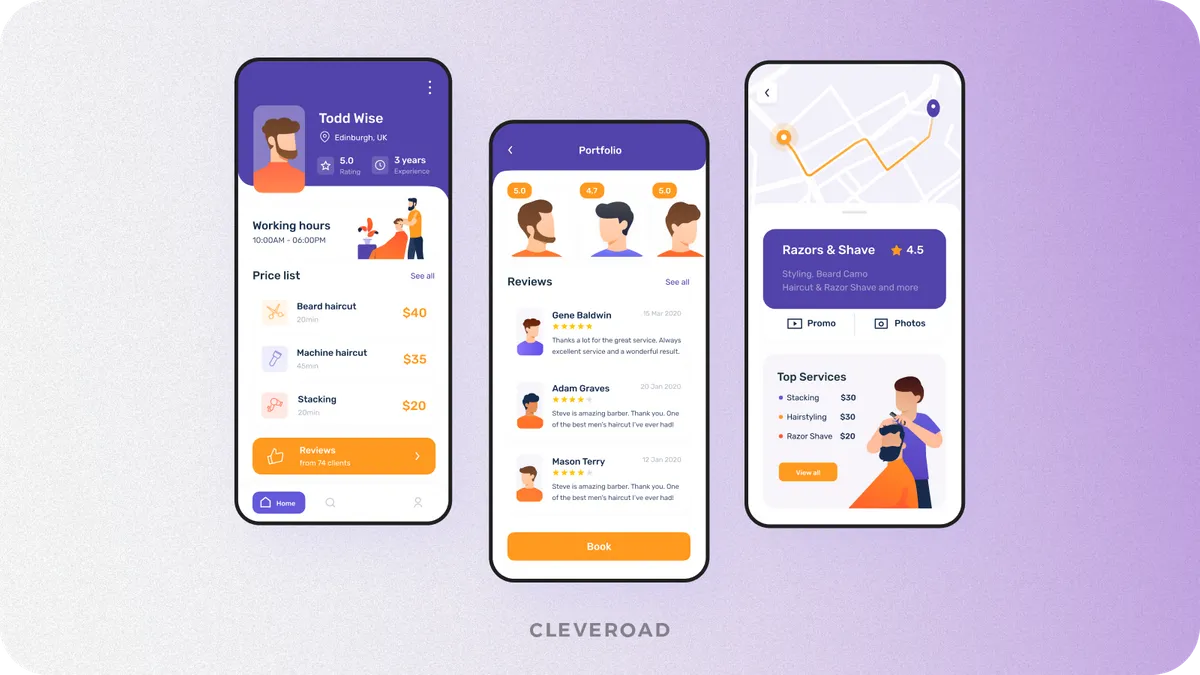
A feedback section of an online marketplace designed by the Cleveroad team (Source: Dribble)
Seller’s side
This side of a marketplace website allows sellers to list products, manage transactions, and communicate with buyers. A well-structured seller interface ensures a smooth onboarding process, easy product management, and efficient order handling.
So, let's take a look at the main seller's side features.
Registration. The seller completes the registration process or signs in with existing social media accounts. After that, the supplier is required to provide personal data, such as company name, phone number, address, links to social media, and more.
Ads. To publish an ad, a supplier should categorize the item and provide an essential detailed description that may incorporate current condition, price, delivery methods, available quantity, existing colors, size range, etc.
Chat implementation. Vendors can communicate with clients via online chat to clarify the deal details.
Payments. Your MVP marketplace must allow sellers to withdraw their income utilizing various payment methods. Sellers need to view payout details and have an opportunity add or change the payout method they appropriate.
Reviews. A section where the supplier is able to overview personal ratings, comments, and feedback left by the customers.
Changing the account type. Many marketplaces offer a direct switch from the buyer to the seller within the user’s account. Users can change their account type in their profile and start managing their shops – pick a name, add items, set up billing, and so on.
Administrating tools. Admin panel allows the seller to adjust settings for various purchaser categories, such as delivery/ payment methods and price, and manage goods.
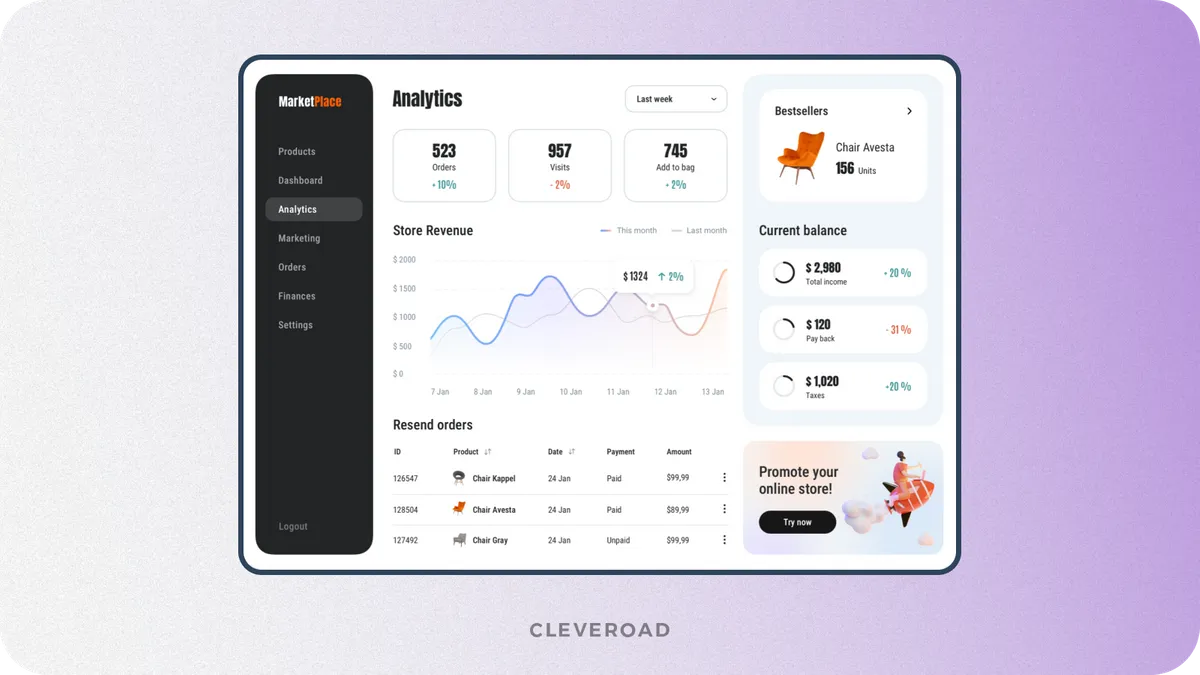
A seller’s side admin section of an online marketplace designed by the Cleveroad team (Source: Dribble)
How Much Does It Cost to Build a Marketplace Website
We’ve covered the key factors that influence the online marketplace app development cost, from development complexity to design choices, technology stack, and hosting expenses. Now, let’s get to the numbers. The cost to build online marketplace platform like the one we’ve described is around $41,200. It's the number based on a $50/h rate (true for Central and Eastern Europe region, Estonia).
| E-markeplace's feature | Approx time (hours) | Approx cost ($) |
Sign up | 11h | $550 |
Sign in | 27h | $1,350 |
Help screen | 26h | $1,300 |
User profile | 60h | $3,000 |
Homepage | 89h | $4,450 |
Shopping cart | 134h | $6,700 |
Add listings | 165h | $8,250 |
Product details | 41h | $2,050 |
Payouts | 25h | $1,250 |
Change account type | 60h | $3,000 |
Seller subscription | 50h | $2,500 |
Admin panel | 136h | $6,800 |
Total | 824h | $41,200 |
How did we get this number? It’s simple: the more hours devs spend on website development, the more much it costs to build. Our business analyst estimated how many hours it would take to develop a marketplace website (including the sellers’ part, backend, and admin panel). Then, to find out the cost of how to build marketplace we multiplied the number of hours by $50. And here’s where these numbers come from.
Tips to Reduce Marketplace Website Cost
There are many hints to reduce the cost of creating an online marketplace development – starting with working with a trusted marketplace website development partner and ending with Agile SDLC. Let’s take a closer look at the main tips to reduce marketplace website costs.
Work with trusted marketplace development partner
Choosing the correct development partner directly affects your marketplace development cost. A reliable vendor improves the workflow and prevents costly errors, which improves the quality delivery of products on time and on budget. An experienced marketplace development vendor understands the costs involved in developing an online marketplace and provides you with the most adequate solutions.
Also, it is important to look for a partner with proven experience, which portfolio must show. Don’t forget about vendor client reviews on platforms such as Clutch to check their quality of services.
Select a suitable engagement model
The selection of an engagement model also impacts the cost of developing a marketplace. For example, we at Cleveroad offer flexible cooperation models so that you can find an option that suits your resource needs:
- Dedicated team: A dedicated team is a model when you’re handing over the end-to-end software development to your vendor team that exclusively works on your product. It is a suitable choice for large-scale and complex projects.
- IT staff augmentation: IT staff augmentation services allow you to quickly onboard external specialists with the experience in the domain you need on a temporary basis. It is the best choice if you need to hire a few specialists solely dedicated to your product.
Prioritize MVP development
Marketplace Minimum Viable Product (MVP) development is also a method to lower cost to build online marketplace platforms. Instead of investing upfront in a product rich with features, focus instead on addressing core functionalities that solve pivotal users' problems.
Deciding to build an MVP, you get the opportunity to check your idea, gather user feedback, and make improvements to your product. Such an approach prevents you from wasting resources on features that will not add appropriate value. Thanks to this, you create a marketplace that meets real customer needs without additional expenses. After successfully launching the MVP functionality, think about more advanced features.
Optimize marketplace for SEO
Search Engine Optimization (SEO) will also help reduce long-term marketing expenses. It helps improve visibility and minimize the need for expensive paid advertising. An ideally optimized marketplace, however, will gain organic search traffic and will not depend much on paid promotions.
We at Cleveroad build websites with SEO in mind to lay the foundation for cost-effective promotion. With 13+ years in the IT market, Cleveroad helped many entrepreneurs optimize their products.
We provided dedicated development team services to our client - a company from the USA called NURSING. The core idea behind NURSING.com is to solve the nursing shortage by improving and simplifying education. Their platform has 300,000+ students. NURSING.com was listed on the Inc.5,000 Fastest-Growing Private Companies in America (319 place) and featured on the Fast Companies World Changing Ideas list as well.
Cleveroad Developed a new web solution to replace their outdated one and made it SEO-optimized and based on NURSING marketing team requirements (according to Google Page Speed Insights) to drive more traffic to their website.
See what Daniel Jones, CTO at NURSING, says about cooperation with Cleveroad:
Daniel Jones, CTO at NURSING. Feedback about Cleveroad's Dedicated Development Team Services
Follow Agile SDLC
Agile SDLC development allows for continuous improvements, faster releases, and efficient use of costs. It removes unnecessary features, improves adaptability, and optimizes average cost in creating a marketplace website and mobile app. Following Agile methodology also minimizes rework and maximizes the efficiency of the available budget.
Cost to Build an Online Marketplace: Cleveroad Experience
Cleveroad is a skilled marketplace software development company with headquarters in the Central and Eastern Europe region, Estonia.
With 13+ years of experience, we provide robust and flexible marketplace software services, including custom marketplace development, software modernization, third-party integrations, and digitalization and optimization. The Cleveroad team develops optimized marketplace solutions that increase traffic, boost conversion, and grow sales. We also build custom marketplaces, such as B2C, B2B, C2C, P2P, multi-vendor, market network, and services marketplace.
To maximize the collaboration efficiency with Cleveroad for our clients, we offer a row of adjustable cooperation models:
- Dedicated Team. By working with a dedicated team, you get top-class developers with a comprehensive experience in the industry you need. You can expand your team with additional specialists, gather an agile-oriented team for a new project, or maintain and update the existing one.
- IT staff augmentation. IT Staff augmentation services let you onboard external developers with the necessary domain competencies on a temporary basis. You can augment your in-house team with the needed specialists with experience in your business domain or hire a few specialists solely dedicated to your product.
- Custom development. This cooperation model ensures that you receive end-to-end software development services. We take care of all the development processes, and you get a tailored marketplace solution aligned with your startup’s needs.
Cleveroad has a lot of years of experience in e-marketplace creation. Now, we’ll show you one of our cases.
We’ve developed a P2P marketplace called AYIO for our client from Switzerland. The main idea of the AYIO app was to provide users with an opportunity to find a specialist in different fields – from travel to plumbing. The Cleveroad team was challenged with the following tasks:
- Adjusting quick switching between two roles to provide users with high-quality service
- Providing UI and UX that should be as simple and intuitive as possible
- Creating a functional and user-friendly platform remaining within the budget for MVP
We provided a customer with an online marketplace solution that made it possible to build a service with a good-looking UI/UX and high performance. Their platform comes with a complex search system, a custom payment account, and real-time activity tracking of income and expenses.
See what the client has to say about collaborating with Cleveroad on the marketplace creation:


Innovate your e-commerce business
Our skilled web development team with 13+ years of experience in e-commerce will deliver a top-quality online marketplace according to your demands
Marketplace development cost varies from $41,000 to $281,000 and higher. The overall cost of building a marketplace from scratch depends on the project's complexity, features, and the region where you hire developers.
Marketplace website development cost depends on the type you choose. The online marketplace involves such types:
- Vertical that occupies one area or niche
- Horizontal that offers goods from a few categories with a secondary character in common
- Global that offers items or services from a wide range of categories
There are such factors that affect the marketplace website development cost. Let’s look from what the costs of the marketplace depend on:
- Marketplace app complexity
- Custom UI/UX design
- Technology stack
- Cooperation option
- Specialists' hourly rates
- Hosting and maintenance
There are such tips to reduce the costs of a marketplace website in 2025:
- Work with trusted marketplace development partner
- Select a suitable engagement model
- Prioritize the minimum viable version of your marketplace
- Follow Agile SDLC
- Optimize marketplace for SEO

Evgeniy Altynpara is a CTO and member of the Forbes Councils’ community of tech professionals. He is an expert in software development and technological entrepreneurship and has 10+years of experience in digital transformation consulting in Healthcare, FinTech, Supply Chain and Logistics
Give us your impressions about this article
Give us your impressions about this article
Comments
2 commentsReally Nice information, which help me to get an idea of costing.
Wow! That’s actually not what I expected. It’s quite easy and affordable. Thanks for gathered information!
